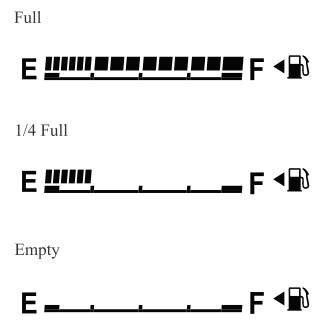Mazda CX-3: Automatic Transaxle / Transaxle Ranges
- The shift position indication in the instrument cluster illuminates. Refer to Warning/Indicator Lights.
- The selector lever must be in P or N position to operate the starter.
P (Park)
P locks the transaxle and prevents the front wheels from rotating.
WARNING
Always set the selector lever to P position and set the parking brake: Only setting the selector lever to the P position without using the parking brake to hold the vehicle is dangerous. If P fails to hold, the vehicle could move and cause an accident.
CAUTION
- Shifting into P, N or R while the vehicle is moving can damage your transaxle.
- Shifting into a driving gear or reverse when the engine is running faster than idle can damage the transaxle.
R (Reverse)
In position R, the vehicle moves only backward. You must be at a complete stop before shifting to or from R, except under rare circumstances as explained in Rocking the Vehicle.
N (Neutral)
In N, the wheels and transaxle are not locked. The vehicle will roll freely even on the slightest incline unless the parking brake or brakes are on.
WARNING
If the engine is running faster than idle, do not shift from N or P into a driving gear: It's dangerous to shift from N or P into a driving gear when the engine is running faster than idle. If this is done, the vehicle could move suddenly, causing an accident or serious injury.
Do not shift into N when driving the vehicle: Shifting into N while driving is dangerous. Engine braking cannot be applied when decelerating which could lead to an accident or serious injury.
CAUTION
Do not shift into N when driving the vehicle. Doing so can cause transaxle damage.
NOTE
Apply the parking brake or depress the brake pedal before moving the selector lever from N position to prevent the vehicle from moving unexpectedly.
D (Drive)
D is the normal driving position. From a stop, the transaxle will automatically shift through a 6-gear sequence.
M (Manual)
M is the manual shift mode position. Gears can be shifted up or down by operating the selector lever. Refer to Manual Shift Mode.
 Shift-Lock System
Shift-Lock System
The shift-lock system prevents shifting out
of P unless the brake pedal is depressed.
To shift from P:
Depress and hold the brake pedal.
Start the engine...
 Shift Position Indication
Shift Position Indication
The selector position is indicated when the
ignition is switched ON.
Gear position indication
In manual shift mode, the “M” of the shift
position indication illuminates and the
numeral for the selected gear is displayed...
Other information:
Mazda CX-3 (2015-2025) Owner's Manual: Low Engine Coolant Temperature Indicator Light (Blue)
The light illuminates continuously when the engine coolant temperature is low and turns off after the engine is warm. If the low engine coolant temperature indicator light remains illuminated after the engine has been sufficiently warmed up, the temperature sensor could have a malfunction...
Mazda CX-3 (2015-2025) Owner's Manual: Jam-safe Window
If foreign matter is detected between the window and the window frame while the window is closing automatically (refer to Auto-opening/Closing on page 3-30), the window stops closing and automatically opens partway. NOTE The jam-safe function may operate under the following conditions: A strong impact is detected while the window is closing automatically...
Categories
- Manuals Home
- Mazda CX-3 Owners Manual
- Mazda CX-3 Service Manual
- Wrench Indicator Light
- Auto Lock/Unlock Function
- Key Battery Replacement
- New on site
- Most important about car
Fuel Gauge
The fuel gauge shows approximately how much fuel is remaining in the tank when the ignition is switched ON. We recommend keeping the tank over 1/4 full.

If the low fuel warning light illuminates or the fuel level is very low, refuel as soon as possible.
If inconsistency in engine performance or stalling occurs due to low fuel level conditions, refuel the vehicle as soon as possible and add at least 10 L (2.7 US gal, 2.2 Imp gal) of fuel. Refer to Taking Action.
